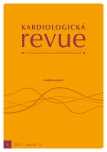Rare cause of mechanical aortic valve dysfunction
Authors:
I. Andršová 1; O. Ludka1 ,2; J. Maňoušek 1
Authors‘ workplace:
Interní kardiologická klinika FN Brno
1; FNUSA-ICRC Brno
2
Published in:
Kardiol Rev Int Med 2011, 13(4): 260-262
Category:
Case reports- competitive
Overview
Introduction:
The following case report describes a rare cause of aortic regurgitation as a late complication of mechanical aortic valve replacement.
Case report:
A 66-year-old man was referred to our hospital with suspected coronary syndrome accompanied by left ventricular heart failure. The patient had had an aortic valve mechanical prosthesis, implanted in 2007 for haemodynamically significant stenosis together with venous bypass of the ACD. Coronary angiography ruled out the haemodynamically significant stenosis of coronary arteries or the aortocoronary bypass. Aortography also ruled out any aortic dissection. Baseline echocardiography did not reveal any mechanical valve dysfunction or other significant cardiac pathology. However, paraclinical and clinical examinations were consistent with the diagnosis of acute left ventricular heart failure. There was no heart murmur on admission. Nevertheless, an intermittent diastolic murmur associated with the disappearance of the sound of artificial valve was detected on day two. Repeated transthoracic echocardiography with subsequent transoesophageal echocardiography was therefore performed. Intermittent, haemodynamically significant aortic regurgitation, caused by a structure attached to the mitral supporting apparatus, was found. Endocarditis or thrombus as the structure etiology was ruled out. The patient was then referred to the cardiac surgery department, where the accessory mitral valve apparatus was confirmed and eliminated through a cardiopulmonary bypass procedure.
Conclusion:
The case history shows the need for detailed physical examination of patients, together with the importance of complementary imaging methods. In the event of any doubts, repeat examinations should be performed without delay. When applying the differential diagnosis approach, rare congenital or other diseases must also be taken into consideration.
Keywords:
aortic regurgitation – mechanical valve prosthesis – mitral accessory hanging apparatus
Sources
1. Tanaka H, Kawai H, Tatsumi K et al. Accessory mitral valve associated with aortic and mitral regurgitation and left ventricular outflow tract obstruction in an elderly patient: a case report. J Cardiol 2007; 50: 65–70.
2. Sono J, McKay R, Arnold RM. Accessory mitral valve leaflet causing aortic regurgitation and left ventricular outflow tract obstruction: case report and review of published reports. Br Heart J 1988; 59: 491–497.
3. Prifti E, Bonacchi M, Bartolozzi F et al. Postoperative outcome in patients with accessory mitral valve tissue. Med Sci Monit 2003; 9: RA126–RA133.
4. Iba Y, Saito S, Kawai A et al. Images in cardiovascular medicine. Mitral valve prolapse associated with ccessory mitral valve. Circulation 2005; 111: e107.
5. Tanaka H, Okada K, Yamshita T et al. Accessory mitral valve causing left ventricular outflow tract obstruction and mitral insufficiency. J Thorac Cardiovasc Surg 2006; 132: 160–161.
6. Popescu BA, Ghiorghiu I, Apetrei E et al. Subaortic stenosis produced by an accessory mitral valve: the role of echocardiography. Echocardiography 2005; 22: 39–41.
Labels
Paediatric cardiology Internal medicine Cardiac surgery CardiologyArticle was published in
Cardiology Review

2011 Issue 4
Most read in this issue
- There’s no hypertrophy like hypertrophy, or don’t forget amyloidosis
- Pericardial calcification
- Non-sarcomeric hypertrophic cardiomyopathies in adults
- Peripartum cardiomyopathy
